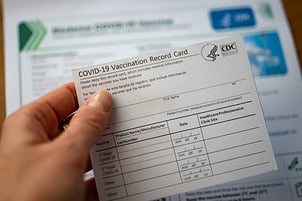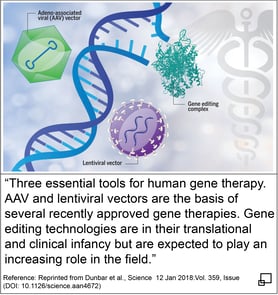
As discussed in my previous article “Portfolio Diversification During Times of Market Volatility,”[1] one of the few positive outcomes of the worldwide pandemic is the increasing recognition of the power of innovation and a desire to participate in this groundswell. Today, I’d like to highlight examples of several life science and related sectors with the potential to transform our world.
 Vaccines: Top of mind obviously are new approaches to vaccine development and manufacturing. Although many of these have been around for years if not decades, they failed to garner the resources needed to bring them into the mainstream. Why? Proactively addressing future outbreaks of yet to be discovered pathogens requires significant investment, which—until the emergence of COVID-19—there was little appetite for. Case in point: messenger RNA-based vaccines. The concept of using mRNA as a vaccine is not new, but was not accepted as a viable approach by the industry until recently: “Using a virus’ genetic material to command a human body to duplicate certain proteins to fight the virus was considered too radical, and too financially risky to fund.”[2] For a fascinating read of the struggles one of the primary inventors of the technology faced, check out “The story of mRNA: how a once dismissed idea became a leading technology in the COVID vaccine race.”[3]
Vaccines: Top of mind obviously are new approaches to vaccine development and manufacturing. Although many of these have been around for years if not decades, they failed to garner the resources needed to bring them into the mainstream. Why? Proactively addressing future outbreaks of yet to be discovered pathogens requires significant investment, which—until the emergence of COVID-19—there was little appetite for. Case in point: messenger RNA-based vaccines. The concept of using mRNA as a vaccine is not new, but was not accepted as a viable approach by the industry until recently: “Using a virus’ genetic material to command a human body to duplicate certain proteins to fight the virus was considered too radical, and too financially risky to fund.”[2] For a fascinating read of the struggles one of the primary inventors of the technology faced, check out “The story of mRNA: how a once dismissed idea became a leading technology in the COVID vaccine race.”[3]
This approach, however, does have its challenges. As discussed in a recent Wall Street Journal Article “mRNA COVID vaccines are fast to make but hard to scale,”[4] the major bottleneck in the manufacturing process is the encapsulation of the mRNA in lipids to protect it and facilitate its uptake by human cells, as well as the required storage at -20C to -80C throughout the distribution continuum. Even with these issues, the fact that hundreds of millions of doses of highly effective vaccines were essentially created from scratch in less than a year is a genuinely remarkable feat and demonstrates the true potential of this method.
The take home message here is that there is significant opportunity for continued innovation in the vaccine space. For example, rapid expression and assembly of antigens into easy to produce, scalable delivery systems are essential, and significant work is underway in these areas. So too is the need for flexible, modular manufacturing solutions capable of responding quickly to emerging threats. VIC portfolio company Filtravate is a leading innovator in the bioprocessing sector with its novel filtration technology, which is a critical requirement for vaccines and therapeutics production.
Diagnostics: Hand in glove with improved vaccines is the ability to rapidly detect new disease outbreaks without involving the development of specific reagents, which greatly slows down the process. PCR-based methods, albeit highly accurate and sensitive, take hours or days to process, are fairly technical, and are not amenable to frontline settings. Consequently, there has been a sizable push for alternatives to detect disease and the underlying cause. To this end, NIH created its Rapid Acceleration of Diagnostic (RADx) program to fast-track the development and commercialization of novel diagnostics, with which the VIC Foundry is actively involved in a development project in collaboration with Sandia National Laboratories.
Another trend in the diagnostics realm is an increase in available at-home tests supporting both telemedicine and improved self-monitoring. An example of a VIC portfolio company working in this space is Vixiar Medical and its non-invasive heart health monitoring technology. Wearable sensors (above and beyond Fitbit) are also a growing component of the segment, with the goal of enabling real-time monitoring of myriad readouts outside the healthcare setting. These include, but are in no way limited to: sports and fitness applications (example: measuring lactate), biomarker tracking (see below), disease monitoring, and patient triaging (measuring markers of trauma). Case in point, the small format, wearable artificial pancreas technology being developed by SFC Fluidics—which recently received breakthrough device designation from the FDA—provides both continuous monitoring and automated drug delivery that can greatly improve health outcomes.
Prevention: Instead of treating the disease after the fact (and the multiple issues that it may cause), the brass ring of healthcare is to prevent disease altogether. As discussed above, vaccines are primary option in the arsenal. Drugs can also be used to avoid the damage resulting from a variety of traumas. Neurexis Therapeutics is developing a neuroprotective peptide that prevents brain cell death following cardiac arrest and stroke. Another category in this space are medical devices such as Solenic Medical’s approach to not just treating, but potentially preventing infections due to biofilms on metal implants.
Tools: Next generation sequencing and bioinformatics. Having been deeply involved during the initial phase of the human genome project back in the 1990s, I am both delighted in and amazed by the progress made during the last several decades. What originally took an international consortium 16 years and $3 billion to do—publish the complete sequence of all 23 chromosomes—can now be done in several days using highly automated, massively parallel advances. Equally important are the improvements in computer processing speed, data analysis and bioinformatic tools which allow insights to be gleaned from the 3+ billion base pairs that make up our genetic maps. These in turn have enabled the accumulation of genetic information from an increasing number of individuals through services such as 23andMe and Ancestry.com, and its distillation into a growing understanding of how even minor differences in our DNA can lead to disease. This will in turn facilitate the development of therapeutics for previously unaddressed indications, and improved, targeted drugs with greater efficacy and fewer side effects.
 Gene Therapy: Since suffering notable setbacks twenty years ago, gene therapy—the delivery of a functional gene that a patient is missing—has made tremendous strides.[5] Over three thousand clinical trials have been conducted or are underway, and a number of gene therapies have been approved to treat disease such as B-cell acute lymphoblastic leukemia, blindness, polyneuropathy and spinal muscular atrophy, using both viral and non-viral vectors. Scientists are continuing to find new approaches to safely and effectively targeting gene delivery to specific tissues and cells, thereby increasing the versatility of this promising addition to the inventory of therapeutic options. Gene editing is just one notable example that has received a great deal of press in recent years.
Gene Therapy: Since suffering notable setbacks twenty years ago, gene therapy—the delivery of a functional gene that a patient is missing—has made tremendous strides.[5] Over three thousand clinical trials have been conducted or are underway, and a number of gene therapies have been approved to treat disease such as B-cell acute lymphoblastic leukemia, blindness, polyneuropathy and spinal muscular atrophy, using both viral and non-viral vectors. Scientists are continuing to find new approaches to safely and effectively targeting gene delivery to specific tissues and cells, thereby increasing the versatility of this promising addition to the inventory of therapeutic options. Gene editing is just one notable example that has received a great deal of press in recent years.
Biomarkers: The arrival of wearable technologies has enabled our ability to monitor a variety of physiological parameters, including step count, speed, and gait, posture, sleep patterns, blood pressure and oxygenation, and continuous heart rate and glucose monitoring. Due to advances in analytical technologies focused on the miniaturization of sensors in combination with improving their ability to monitor select biomolecules, we are gaining a better understanding of how the molecular profile in blood, sweat, tears, breath and urine serve as indicators of health, and may serve to inform our daily nutrition, exercise and medication choices as well. This, combined with dramatic improvements in detection technology, will result in improved quality of life for those who embrace this innovation. It will also permit the development of better, safer drugs by directly tracking their effect on these readouts. In addition, these advances will support the personalization of medicine by better classifying individuals based on the rich datasets provided by these technologies.
Healthy aging: Continuing on this theme, our growing knowledge of biomarkers, metabolic pathways, nutrition, supplements and other emerging fields will greatly influence lifestyle and longevity. Where I live, it’s referred to as “Boulder older”: People who maintain active lives well into their 60s, 70s and even 80s: Hiking, skiing, cycling and more. Making this possible for everyone—regardless of income, geography or other demographics—is essential, especially given the reduced burden on healthcare resulting from avoiding or delaying the onset of chronic illnesses of aging. While holistic measures such as exercise are undoubtedly effective, for some individuals, these interventions may be difficult to implement. In these instances, and for the population at large, research into the molecular mechanisms of aging is revealing a variety of therapeutic targets that can be modulated to attain similar or enhanced effects.
 Sustainability: Last, but most certainly not least, clean air, healthy food and drinkable water are essential to life and an ever-growing concern as the human population climbs toward eight billion and climate change disrupts ecosystems. This is an ongoing area of focus for VIC, with several portfolio companies directly addressing these challenges. Akeso Biomedical has created an alternative to antibiotics for the prevention of disease and improved health in our food supply. BlueInGreen (recently acquired by Chart Industries) is reinventing the water cycle through advances in treatment technologies. Other opportunities in the space include smart farming through improved sensors, analytics, advances in plant genetics and pest control.
Sustainability: Last, but most certainly not least, clean air, healthy food and drinkable water are essential to life and an ever-growing concern as the human population climbs toward eight billion and climate change disrupts ecosystems. This is an ongoing area of focus for VIC, with several portfolio companies directly addressing these challenges. Akeso Biomedical has created an alternative to antibiotics for the prevention of disease and improved health in our food supply. BlueInGreen (recently acquired by Chart Industries) is reinventing the water cycle through advances in treatment technologies. Other opportunities in the space include smart farming through improved sensors, analytics, advances in plant genetics and pest control.
These are just a few examples of the areas of innovation the VIC team are tracking closely to identify new investment opportunities. Stay tuned for updates as we make further progress in 2021 and beyond.
- https://blog.victech.com/portfolio-diversification-during-market-volatility
- https://www.goodnewsnetwork.org/katalin-kariko-hungarian-chemist-developed-covid-19-mrna-vaccine/
- https://www.statnews.com/2020/11/10/the-story-of-mrna-how-a-once-dismissed-idea-became-a-leading-technology-in-the-covid-vaccine-race
- https://www.wsj.com/articles/mrna-covid-19-vaccines-are-fast-to-make-but-hard-to-scale-11614776401
- https://science.sciencemag.org/content/359/6372/eaan4672

